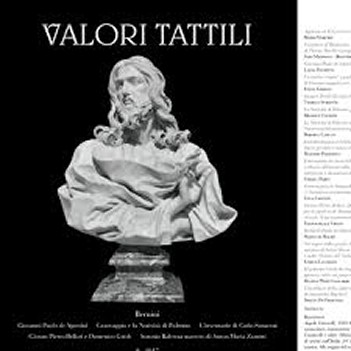
Imago Christi: Bernini Saviours, Lost and Found
Charles Scribner III
 --for the published article in Valori Tattili, 9-2017, pp.49-59, click link: https://www.scribd.com/document/353355340/Imago-Christi
--for the published article in Valori Tattili, 9-2017, pp.49-59, click link: https://www.scribd.com/document/353355340/Imago-Christi
The imago Christi—Gianlorenzo Bernini’s image of Christ—is the subject of the most significant recent attributions to the canon of his works. They portray Christ not within narrative, dramatic, multi-figure (or multi-media) works, the bel composto that is Bernini’s hallmark, but rather as iconic and singular objects of devotion--focal points of veneration. One is a nearly life-size crucifix; the other, a larger-than-life bust of the Savior.
Bernini’s first documented commission for a crucifix was early in the reign of Pope Urban VIII, during the construction of the greatest bronze masterwork in Rome, the Baldacchino at the Crossing of St. Peter’s. That bronze crucifix on an ivory pedestal adorned with precious stones was commissioned in 1627 for the first chapel on the right, closest to the Porta Santa, but appears not to have been executed. One must fast-forward almost three decades to view the first of Bernini’s extant crucifixes, the almost life-size bronze crucifix commissioned around 1653-4 for King Philip IV of Spain for the royal burial chapel in the Escorial, probably at the behest of Bernini’s erstwhile nemesis Pope Innocent X, who pursued a pro-Spanish policy in contrast to his Francophile predecessor Urban VIII.
Bernini’s son and biographer Domenico described it as “larger than life size” but that is surely an exaggeration of a figure of four and a half feet in height, even back then. The chapel was completed in 1654; Bernini’s honorarium, according to his son, was “a large gold chain.” The crucifix was noted in situ in 1657 but soon afterwards moved to the sacristy.

Bernini, Crucifix for Philip IV (Escorial, Spain)
After the death of Pope Innocent, Cardinal Antonio Barberini ordered from Bernini (c.1655) a crucifix for his residence in Paris. Donated to the King after Barberini's death, it was listed in Louis’s inventory of 1684, just four years after the maestro’s death, but disappeared from the royal inventories by 1788, before the Revolution, and its whereabouts remain unknown. Still another crucifix is mentioned by Bernini’s biographer Baldinucci as having been “made for himself” and during Bernini’s visit to Paris in 1665 given to the Jesuit cardinal Sforza Pallavicino, who was looking after the Bernini family back in Rome and mentoring Bernini’s son Monsignor Pietro Filippo. Five years earlier Pallavicino had penned his monumental History of the Council of Trent, for which he hoped Bernini would design a title page. Bernini was too busy, but to his gift of a crucifix he added, a year later, a chalk portrait of the cardinal (Yale University Art Gallery, New Haven).
In 1908 a large bronze crucifix was exhibited in Venice and bought the next year by the Parisian art dealer Raoul Heilbronner, who sold it to New York financier Thomas Fortune Ryan as “school of Jean de Bologne” (Giambolgona). Purchased from his estate in 1933 by Geraldine Rockefeller Dodge, it was included in her estate sale at Sotheby’s Parke-Bernet in 1975 as “French late 17th century,” but failed to sell. Subsequently purchased by a dealer, it wound up in Monte Carlo and in 2002 was upgraded to Bernini by Maurizio Fagiolo dell’Arco, who believed it to be the lost crucifix given to Cardinal Barberini for King Louis XIV. 
Follower of Bernini, Corpus (Art Gallery of Ontario, Toronto)
Three years later, Tomaso Montanari published it as the lost Pallavicino crucifix, praising its remarkable quality worthy of Bernini: “notevolissima e assolutamente berniniana” Offered to several museums, it was finally sold to a Canadian businessman, Murray Frum, who donated it to the Art Gallery of Ontario at a stated value of fifty million dollars. There it claims pride of place on dramatic display, with nary a public doubt in the face of the long list of scholars and curators solicited to bolster the attribution. But is it really Bernini’s lost crucifix? More to the point, is it by Bernini?
Viewing the two side by side, one may catch a glimpse of an explanation for why over the decades following its exposition in Venice the Toronto crucifix never conjured up the name Bernini. Certainly by 1975—the sale at Sotheby’s--Bernini was widely studied; Wittkower’s monograph and catalogue raisonné, which included Bernini’s crucifixes, had been in print for twenty years. Yet no one saw Bernini’s handwriting in the piece. Compared with the original in the Escorial, it appears at first glance svelte, delicate, lacking the muscular dynamism of the original: Bernini Lite.
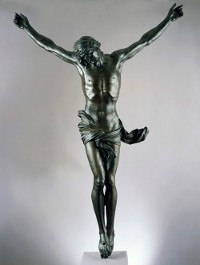
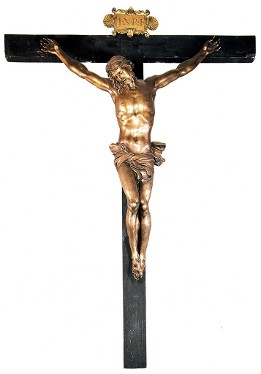 Left: Toronto Corpus Right: Escorial Corpus
Left: Toronto Corpus Right: Escorial Corpus
Montanari describes the pair as “fratelli, ma non gemelli.” Brothers, not twins. There are telling discrepancies, to be sure, beyond the overall prettification of the Toronto bronze, with its emphasis on greater articulation of the ligaments and toes in the feet, the accentuated crown of thorns, and flourish of drapery.
First, what is missing? The side wound—that significant detail in all Bernini’s other crucifixes of the Cristo morto, as may be seen in the crucifixes he designed in 1658 for the altars of St. Peter’s. This wound signifies the dead Christ since it was inflicted by the lance of the centurion Longinus—the subject of Bernini’s earliest and most monumental marble in the basilica. The alternative type, the Cristo vivo--Jesus suffering and expiring on the cross--was designed by Bernini a year later, in 1659, for the remaining altars. The Escorial crucifix clearly reveals the wound, which in bronze is added at the point of final chasing. It is inconceivable that Bernini would have allowed it to be omitted in a second cast made expressly for his own devotion.
Montanari finesses this problem by arguing that in returning to this crucifix a few years later, Bernini “ha voluto trasformare un ‘Cristo morto’ in un ‘Cristo’ ancora vivo, ma prossimo allo spirare”: in other words, a novel third type to be seen nowhere else in his oeuvre or indeed in the iconographic tradition of crucifixes: that of Christ at the very point of death, a comatose Christ. He reinforces his theory by invoking the unique fling of loincloth—a striking detail alien to Bernini, here requiring an additional cast of bronze to be amended to the Escorial original. (This motif is, to be sure, typical in crucifixions by Guido Reni and Algardi—but never by Bernini.) Montanari interprets this mannered flight of fabric “quasi che l’ultimo sospiro di Gesù lo sollevasse”–as if raised by Jesus’s last sigh.
Montanari’s argument is clever, but specious. Bernini was consistent in his treatment of compact, lively drapery throughout his crucifixes, expressing the tension and pathos inherent in the figure itself, as seen in an exquisite bronze made from Bernini’s clay modello for the Escorial crucifix.
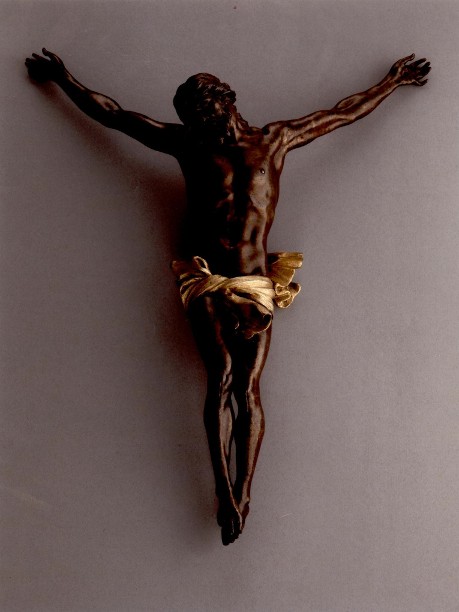
Bernini, Crucifix for Alexander VII (Private Collection, Germany)
Bernini later had that (now lost) modello cast as a devotional crucifix for Pope Alexander VII. Today in a private German collection, it reveals—like all Bernini’s autograph modelli—the maestro’s immediate touch. Immediately noticeable is the absence of a crown of thorns, consistently absent in the 25 crucifixes Bernini designed at this time for St Peter’s, as in his marble crucifix held by St. Jerome for the Chigi Chapel in the Siena Cathedral a few years later (1661-3). So much for Montanari’s hypothesis that the more articulated crown of thorns in Toronto reflects Bernini’s revised, personal vision.
Comparable measurements of both crucifixes suggest that the Toronto casting likely made from some of Bernini's original molds, or copies thereof--but not the casts of drapery. In conclusion, it is highly improbable that Bernini had any role in this later casting or in the finishing details in wax and final chasing. The coda of drapery in the Toronto corpus—requiring an additional mold and alien to all known Bernini crucifixes--betrays the Toronto bronze as a pastiche, a later recasting neither overseen nor molded in wax by himself, much less for himself. Parts of that highly finished corpus—the head and upper torso, above all--appear identical to Bernini's original in the Escorial; yet others—the drapery, exaggerated feet and slimmer legs--seem arbitrary, utterly lacking in Bernini’s handwriting.
* * *
The Sign of the Cross was to play a signal role in Bernini’s final sculpture, the bust of the Savior, in which the eighty-year-old maestro “summarized and condensed all his art,” Domenico writes, adding that his father’s “bold conception” more than compensated for the “weakness of his pulse [or wrist].” [20]Bernini undertook this parting work as a gift for Rome’s preeminent Catholic convert, Queen Christina of Sweden. When she refused to accept it, saying she could never afford to repay Bernini for its true worth, he bequeathed it to her. On his deathbed he asked for Christina’s prayers since she shared “a special language with God.” It was precisely through Bernini’s special language of gesture that his otherworldly “speaking portrait” of the Lord communicates its meaning. [21]
The bust was originally mounted on a Sicilian jasper base and supported by two angels kneeling on a gilded wooden socle. Bernini’s sketch (in Leipzig) for the angelic pedestal reflects his drawing (also in Leipzig) of similar angels elevating a monstrance to display the sacramental Body of Christ.
Bequeathed by Christina to Innocent XI, Bernini’s Savior was later adapted, as Lavin discovered, as the official emblem of the Apostolic Hospital in Rome before vanishing from the Odelscalchi collection in the late eighteenth century. Only a preliminary drawing (in Rome) preserved Bernini’s redeeming image until Irving Lavin published the marble at the Chrysler Museum in Norfolk, Virginia, as the lost bust.

Copy after Bernini, Bust of the Savior (Chrysler Museum, Norfolk, Virginia)
This was followed a year later by the discovery--at the French cathedral of Sées --of the copy commissioned by Bernini’s Parisian friend Pierre Cureau de la Chambre. While the latter bust reveals a classical beauty and polish typical of a competent copyist, the Norfolk version, on the other hand, appears almost Gothic by comparison, and it remained puzzling even if generally accepted.
Four decades later, a more brilliant candidate was discovered in an obscure niche in the monastery attached to San Sebastiano on the Appian Way. Formerly in the sacristy of the Albani Chapel, it corresponds precisely in measurement, along with its Sicilian jasper base, to the bust recorded in the Odescalchi inventories. Its handwriting—literally—corresponds to Bernini’s blessing bust of Pope Clement X (Galleria Nazionale d’Arte Antica, Rome). Lavin himself authenticated it, demoting the Norfolk bust to a copy. The lost Savior seemed at last to have been found; it never left Rome.
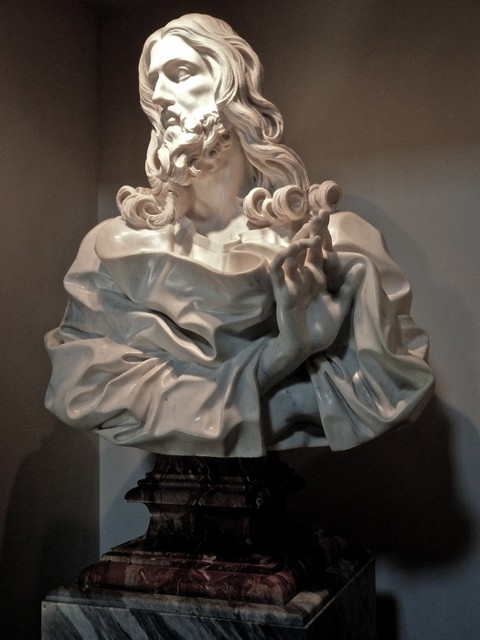
Bernini, Bust of the Savior (San Sebastiano, Rome)
But controversy is the spice of connoisseurship. Brilliance and quality offer no immunity. So even this late discovery of the Savior, lost and found, has provoked denials from at least two distinguished scholars: Jennifer Montagu and Tomaso Montanari. Both see the Norfolk bust as the original, the San Sebastiano as the polished copy by an anonymous member of Bernini’s circle. Here is Montagu’s verdict: “I'm convinced that he made the Saviour in Norfolk, Virginia, which is completely mad, and not the rather academic one in San Sebastiano, which now most people think is by him, but I can't believe this. The late sculptures are mad and hard to take, but interesting.”
Montanari, too, considers the San Sebastiano bust “una bellissima e sensibile copia” of the Norfolk original. While acknowledging its high quality, he perceives in it nonetheless “un linguaggio meno eroico e più grazioso” --more graceful than heroic. The Norfolk bust’s inconsistency in quality illustrates, in his view, Domenico’s reference to his father’s “weakness of wrist.” But that raises the key question: with a workshop of eminent sculptors at hand, masters in their own right who had assisted Bernini for years in realizing his grand programs, would he have settled for a work that betrayed weaknesses, especially a work he considered the summation of his art, his most precious piece and legacy? There was nothing weak about Bernini’s eye or mind as he approached the end. Side by side, which one-- after a career of seven decades and eight popes--would the maestro himself have chosen as his parting masterpiece, the work he called his beniamino, his favorite?

Today displayed in a grand niche in the church proper, the San Sebastiano bust reveals in full glory Bernini’s magnificent sunset in marble. It is well worth a pilgrimage along the Appian Way. Clearly no simple blessing, the unusual gesture that Lavin first interpreted as an ambiguous combination of abhorrence and protection may on one level recall—but not, I must stress, illustrate-- the “noli me tangere,” that first appearance of the resurrected Christ to Mary Magdalene: “Do not touch me, for I have not yet ascended to the Father” (John 20:17). Evoked through Christ’s aloof visage and raised hand—an unexpectedly cautionary gesture—Bernini’s biblical allusion would have been reinforced by the angels that, with hands covered, lifted the divine effigy above the touch of mortals. When designing a symbolic globe to raise his Louis XIV in a royal apotheosis, he explained that its practical function was to prevent viewers from touching the bust. Considered afresh in its original context, as a sacramental apotheosis, the Savior may finally come into focus. The features that seem exaggerated up close, together with the tumultuously abstracted drapery folds and the blank eyes of classical Roman portrait busts, are resolved into an expression of enormous spiritual intensity when viewed from below. Its concetto is emphatically Eucharistic — a huge white Host elevated as “the Bread of Angels.” This is Bernini’s marble sacrament, raised in his last labor of adoration.
Yet the literally crucial question remains: what is the primary, simplest meaning of Christ’s gesture? According to the poet-playwright Hugo von Hofmannsthal, “Die Tiefe muß man verstecken. Wo? An der Oberfläche.” Depth must be concealed, on the surface—a notion with which Bernini would have concurred. One need not diminish, much less deny, the multilayered depths of Bernini’s iconography by insisting that Bernini’s shimmering surface always makes dramatic sense. His son and biographer Domenico described the gesture “come in atto di benedire” (“as if in the act of imparting a blessing”). If anyone knew what that gesture meant, Domenico did. We may take him at his word.
There has been no shortage of exegesis on this point. One scholar interprets the gesture in reference to Christ’s prayer to his Father in the Garden of Gethsemane to ward off the chalice of his Passion. Another maintains that “the diverging movements of gaze and hand argue against a blessing gesture” and he sees the swirls of drapery and hair as alluding to “the tempest which accompanies the second coming of Christ….In short,” he asks, “should we see Bernini’s Christ as repelling the damned souls on Doomsday?” No.
Lavin is surely correct in emphasizing salvation in his interpretation of the gesture as eschatological: “The beneficent shielding gesture of the Savior’s right hand abhors the sinister threat from the lower left,” he concludes. Above all, Lavin focuses on the “powerful contrapposto that is …unprecedented in an isolated image of the Savior.”
It is precisely that contrapposto that provides the key to Bernini’s immediate, implied action. One need not plumb iconology to recover that surface message—literally, the signing of the hand. If one takes Domenico at his word, then–in the spirit of Occam’s Razor--the answer is obvious: what Bernini has captured in stone is the act of blessing. The maestro of movement in marble leaves as his parting tour de force not an icon, a static Christ with hand symbolically raised in blessing, but a dynamic divine figure caught at the moment he is about to complete the horizontal sweep of the cruciform blessing, a moment—and movement--familiar then as now to every Catholic who has attended Mass.
Most images of Christ blessing, like those familiar images of popes or saints on holy cards, show the figure in static equilibrium, his right hand raised at the center of his breast. Not Bernini. This contrapposto is analogous to his early David (Galleria Borghese, Rome). The frightening power of that figure--what makes the viewer want to duck—is the fact that we know what will happen in a second, as the arm swings across the body of this heroic ancestor of Christ. 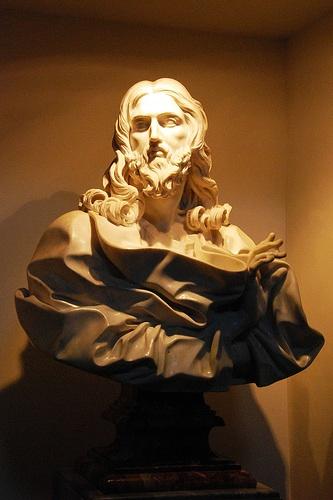
So too in the Savior, whose right hand will momentarily, if more benignly, sweep across his chest to his right side, in which direction his gaze is already turned. The practical purpose of the contrapposto is to evoke a sweeping blessing mirrored and anticipated in Christ’s enlivened drapery. In the end, it’s all about movement. The angels elevate the Savior in Eucharistic benediction as he reaches to complete the act of blessing the world below with the sign of the Cross, the axis of salvation. That is the implied kinesis.
On a deeper level, the point at which the act of blessing is here shown frozen forever in marble underscores Lavin’s interpretation of this gesture as ambivalent—simultaneously blessing virtue and warding off evil. Thus in a final stroke of genius, as he prepared for his own death, Bernini here combined in marble the effect of movement—the familiar act of blessing—with a sublime gesture that signifies Christ as Salvator Mundi, the world’s Savior. Its redemptive theme—orchestrated in a major key—may be found in the maestro’s own words as recorded by Domenico: “God’s goodness is infinite, and infinite is the merit of the precious blood of His Son; and thus it is an offense to these attributes to doubt divine mercy.”
According to his biographers, Bernini’s career commenced with the posthumous bust of Bishop Santoni, a public effigy (Sta. Prassede, Rome); seventy years later, it concluded with a sacramental bust of the Eternal Savior, animated through marble folds that follow no natural pattern. The striking realism of the child prodigy was transfigured in the end by the ethereal vision of a genius to whom life and art were as inseparable as fact and faith.
Renaissance Society of America,
Boston, 2016
R. Wittkower,
Gian Lorenzo Bernini, London, 1966, 268. See also L. Rice,
The Altars and Altarpieces of St. Peter’s: Outfitting the Basilica, Cambridge (UK), 1997, 182-186.
H. von Hofmannsthal, Buch der Freunde (Gesammelte Werke in zehn Einzelbänden, 10), Reden und Aufsätze III, Frankfurt 1986, 268.

![]()

![]()
![]()
![]()
![]()
